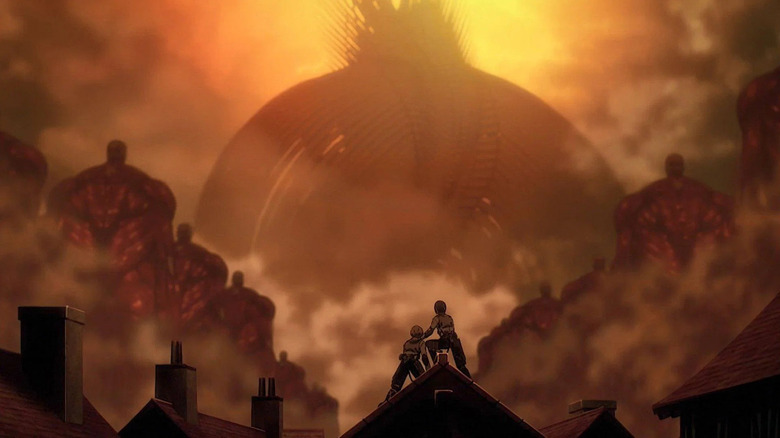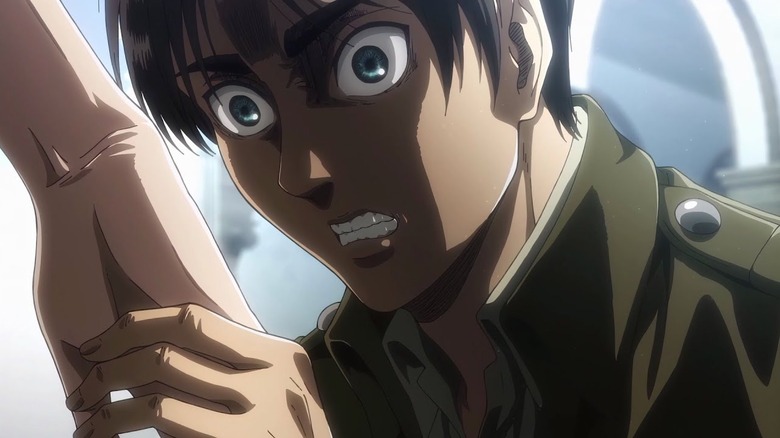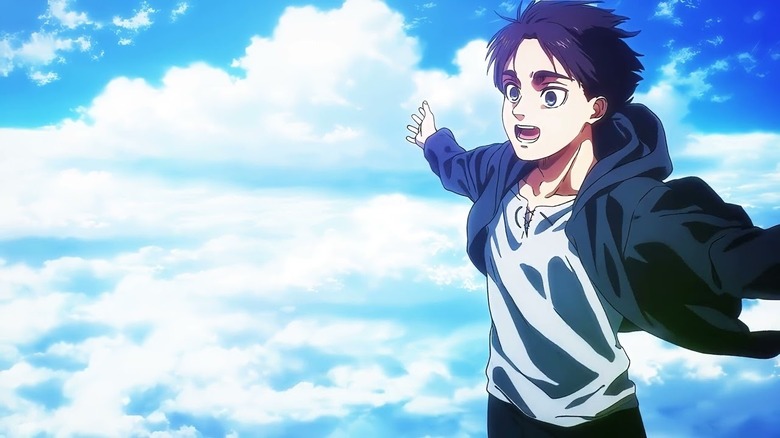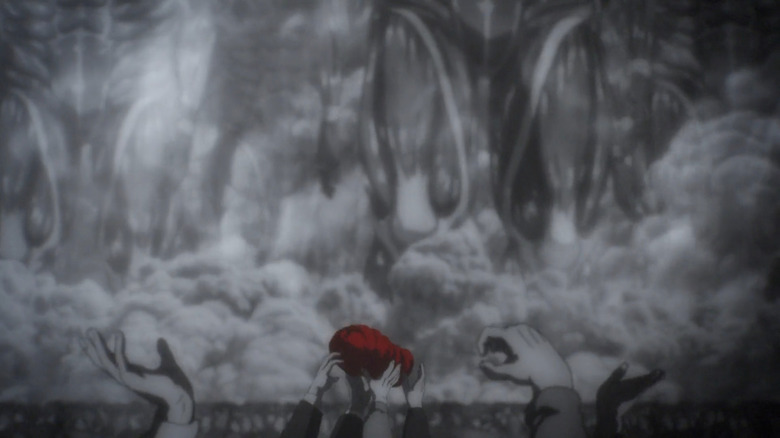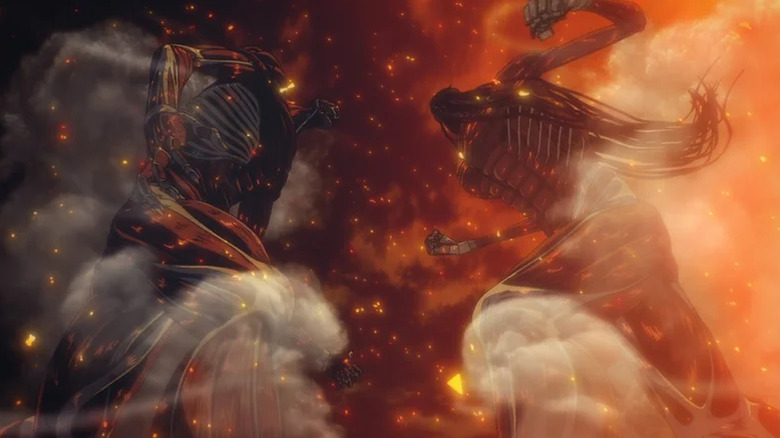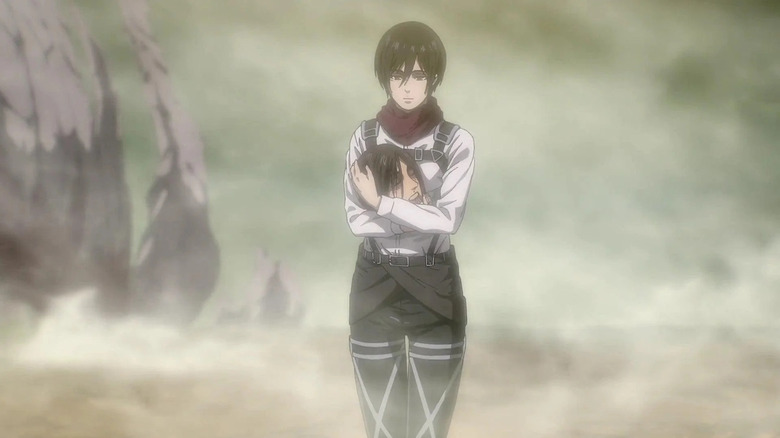Why Did Eren Yeager Start The Rumbling On Attack On Titan?
"Attack on Titan" is arguably the defining anime of the modern era. It's a show that rode the wave of the huge shift toward simulcast streaming to become a cultural phenomenon, breaking into the mainstream and getting everyone talking about it — even if they had never watched another anime before. It's easy to see why; "Attack on Titan" is the perfect series for anime newcomers and has the same broad appeal as blockbuster genre shows like "Game of Thrones" and "The Walking Dead."
Part of what makes "Attack on Titan" such a thrilling and successful show is its approach to mystery and worldbuilding. Unlike, say, most U.S. genre shows after "Lost," "Attack on Titan" doesn't have a mystery box storyline; rather, it uses its characters to drive the plot and, in doing so, develop its own lore and mysteries. Every season of "Attack on Titan" radically changes what the audience and the characters previously thought they knew about the show's setting, recontextualizing what came before and introducing one shocking plot twist after another.
The twists work because they serve the story of the characters and their arcs. Take protagonist Eren Yeager and his shocking turned to villainy, with his motivation and plan becoming the biggest mystery of the fourth and final season. Season 4 also keeps Eren at arm's length from the audience, trasnforming him from our point-of-view character into more of a side player who barely shows up. Whether Eren had a plan to save the island of Eldia from the hatred and combined militaries of the world or not was a point of many discussions amongst fans as the season unfolded. Then came The Rumbling, the crux of the final season and the point of no return for Eren, who unleashed armageddon on the world seemingly out of nowhere.
Though the reason for Eren starting The Rumbling was clearly expressed in the final episode of the show, there were still those who wanted more, either expecting a different answer or hoping that "Attack on Titan" creator Hajime Isayama — who himself has explained extensively what happened and what Eren was thinking — would pull one last twist. In case you need further convincing, or if you simply decided not to watch the show and want to spoil yourself for one of the best TV endings of all time, here's a handy guide for you.
Eren saw an inevitable future (sort of)
Towards the end of season 3 when Eren kisses Historia's hand, he gets a terrifying vision. He sees back in time to the night his dad killed the Reiss royal family, but he also sees other things his father saw that night, including visions of the future and glimpses of The Rumbling itself. This is because Eren is seeing his dad's memories from a night when his dad himself saw Eren's future memories of the Rumbling, allowing the then-present Eren to see it. Thus, the moment Eren kissed Historia's hand, he resigned himself to a horrible future where he'd have to destroy most of humanity. Eren was trapped in his own powers, much like Isayama was stuck writing towards an ending he'd come up with from the start.
So, what was Eren's plan? As he explicitly spells out in the very last episode of "Attack on Titan," Eren decided to make himself the bad guy in order to unite humanity against him while also making his friends the heroes that saved the world. That meant bringing his half-brother Zeke to the island of Paradis and starting The Rumbling, ensuring that about 80% of the world's population would perish. Granted, this wouldn't exactly end all war or hatred in the world, but it would simply level the playing field so that the world inside the walls would be about as big as the world outside. In other words, there would be as many Eldians as there are people who hate them.
Except, to quote Dakota Johnson, "Actually, no. That's not the truth, Ellen." At least, not the whole truth. The supposed vision of the future that Eren saw and seemingly doomed him to his own fate was really just a self-fulfilling prophecy. That's because, as Grisha says when he gets Eren's future memories, Eren is only showing him part of the future, not the whole thing. Eren sent his father (and thereby his past self) specific images that would validate past Eren's own pre-conceived ideas and fatalism. These images were likewise designed to send Eren down the path to starting The Rumbling and ignoring any other alternatives.
Eren saw a world he wanted to see burn
Here's the thing about the "Eren was doomed to the future" thing: If Eren had seen a horrible future involving an actual armageddon and wanted to stop it, he would've tried to avoid the future where he put himself in the exact circumstances needed for The Rumbling to happen. But that's not what Eren did. His future wasn't pre-written, he made conscious choices at every turn because Eren wanted this to happen. He chose his own fate.
It wasn't the vision Eren saw when he kissed Historia's hand that changed him, his demeanor and worldview had already changed much earlier. It was really the moment Eren reached his father's basement and learned the truth of the world that changed everything for him. This was also the moment where he realized the world was not what he hoped it would be. Not because of the prejudice against Eldians or the atrocities committed against his family and people. No, what really left Eren shocked and appalled was learning that there were other people out in the world.
From the very first moment we met him, Eren has always been about one thing and one thing only: freedom. This idea drives every decision Eren has ever made, and everything he's ever done was in pursuit of the world he saw in Armin's picture book — one full of beautiful and, most importantly, empty landscapes. When Eren saw the truth (that the world was full of countries, societies, and people), he became disappointed. More than the goal of saving his friends or destroying the armies that had oppressed the Eldian people for so long, his desire to wipe everything away and leave a clean slate similar to what he saw in Amin's book superseded everything else in Eren's mind. For him, freedom means one thing: a world free of people, unsullied by humanity.
In the end, the real reason Eren started The Rumbling had nothing to do with avenging his fallen friends, the trauma from losing his mom to a Titan, or even protecting his loved ones. No, Eren Yeager started The Rumbling for the same reason Walter White became a drug kingpin in "Breaking Bad", ie. "I did it for me." As Eren tells Armin in the very last episode of "Attack on Titan," he was always just "a garden-variety idiot who got his hands on power."
How many people died during The Rumbling?
The answer to the above question is made pretty clear in the show itself, with Eren explicitly saying he calculated the human cost of The Rumbling to be about 80% of the total world population. First, there are the many, many folks on Paradis Island itself who die when the walls come down. This is also another nail in the coffin of the "Eren did it to save his people!" theory since he still killed a ton of his own people (on top of those dead from the hundreds of thousands of Colossal Titans). Then, as the Titans start walking away from the island, they destroy everything in their path, beginning with the Mediterranean-inspired nation of Marley.
In the last episode, we finally get a glimpse of what other countries look like in the world of "Attack on Titan," which includes analogs for Japan, the United Kingdom, and even an African nation. As the Colossal Titans flatten the world, they leave nothing behind — with not just their huge bodies destroying everything in their path, but also the heat they emanate burning everything. The result is exactly what Eren wanted: a world that looked like Armin's book, free of humans but with "Water that glows like fire. Fields of ice. Giant rocks that take days to climb."
Some of the most heart-wrenching and upsetting images in a series already upsetting and heart-wrenching enough come in the final episode, where we see huge crowds panicking and trying to run away only to be crushed by the Titans. This culminates in a scene straight out of Steven Spielberg's "Schindler's List" where we see a crowd running from Titans and onto a sea cliff. Suddenly, the screen goes black-and-white except for a mother and her baby, who are in full color. When the mother falls over, she lifts her baby to others, who start passing it around in a desperate attempt to let the baby live but a few seconds longer. Notably, the baby is wrapped in red cloth, much like the little girl in the red coat in Spielberg's masterpiece.
This is the entire point of "Attack on Titan." It might be bleak as hell, but the series always fought for and argued in favor of hope, insisting that it's always worth it to try to save a life even while the world itself is falling apart.
How did The Rumbling stop?
The Rumbling seemed like a true armageddon, with Eren serving as the devil himself, becoming impossible to reach, let alone defeat. Remember, at this point Eren is surrounded by hundreds of thousands of Colossal Titans, and he himself is an even bigger monstrosity.
The plan to defeat Eren really took the colossal efforts of everyone — not just the heroes we'd been following since the beginning of the show, but also the people they'd come to regard as villains. It's part of the magic trick "Attack on Titan" pulled in its final episode, allowing it to become a completely different show (one where heroes became villains and villains became heroic). The plan involved the former scouts battling an army of former Beast Titans while Levi manages to kill Zeke, ending Eren's connection to the powers of the Founding Titan and stopping the Rumbling. Of course, that still leaves Eren himself. As such, it falls to Mikasa, the girl who has loved Eren since they were kids, to chop off his head and end his reign of terror.
What happened to Eren Yeager after The Rumbling
Well, Eren is dead by the time The Rumbling ends, so not much technically happens to him after that. Before his death, however, he releases the memory of a conversation he had inside every one of his friends' minds leading up to the final fight. In those conversations, Eren explained his actions — or at least the excuse he wanted them to believe about sacrificing himself for the others.
With Eren dead, the worm-like creature that originated the power of the Titans also dies, ending the power of the Titans forever. Still, though most of humanity is dead, that doesn't exactly stop the cycle of hatred and war. In an epilogue during the end credits, we see the future of Paradis and the many wars fought in the background of Eren's gravesite throughout the ages that followed. "Attack on Titan" argues that you can't really stop humanity from hating and waging war; all you can do is teach the next generation to choose understanding before violence ... and to not trust a homicidal teenager who insists genocide is the only answer because of something he saw in a vision.
